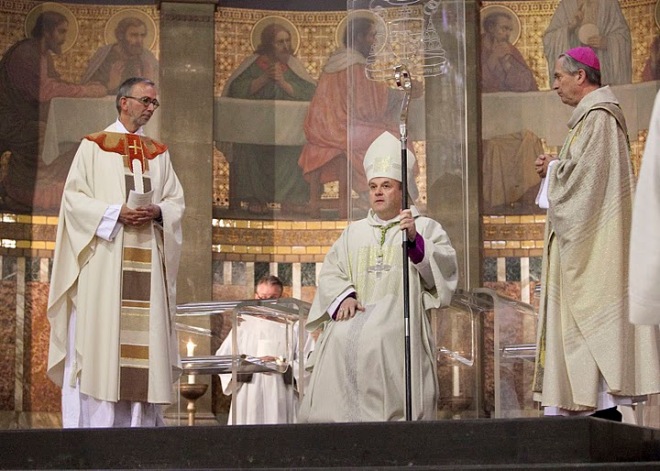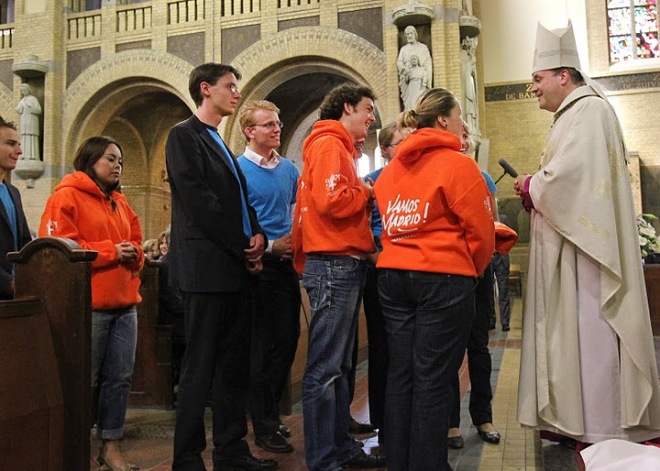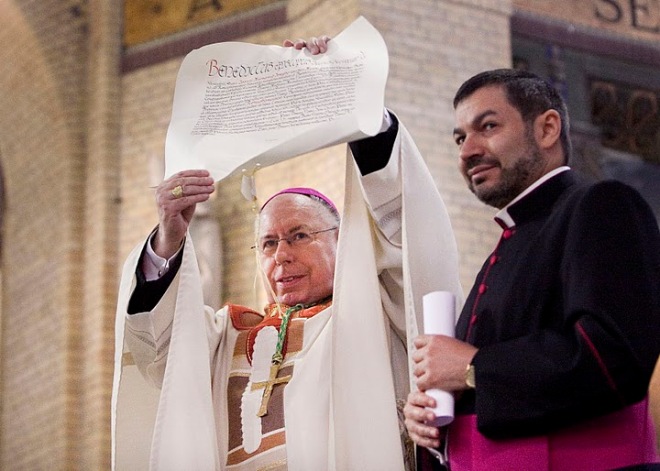Bishop Frans Wiertz of Roermond devotes his Advent letter to the topic of the religious, the people who consecrated their lives and themselves to God:
 “Brothers and sisters,
“Brothers and sisters,
In this time of Advent we begin a new Church year. A year that Pope Francis has declared as the Year of religious life, consecrated life. Religious are not some different breed of people, but just like us, faithful who are living “in the world”, according to the three evangelical counsels: obedience, poverty and chastity.
They live together in a community of brother or sisters, according to a certain spirituality. Sometimes they have come together around a common goal. The communities in which they live are often called monasteries. The religious who lead a contemplative and withdrawn life, do so in abbeys.
It may seem as if almost no one in western Europe joins a monastic community anymore. But there are some 900 religious living in our diocese. Many are elderly and with a great service record, but there is also a significant number of young religious. Recently some new monastic communities settled in Limburg.
Many people associate abbeys, monasteries and monastic life with the long gone days of the “Rich Roman Life”. But nowadays, both in traditional monastic life and on its peripheries, interesting things are happening all the same.
From the media we may sometimes even assume that there has never been so much interest in monasteries, monastic life and products from monasteries. Our Pope Francis himself is a religious. In films and television programs monastic life continues to thrive. After the impressive films “Into Great Silence” about the monks of Chartreuse and “Des Hommes et des Dieux” about Trappists in northern Africa of some years ago, the RKK television series about monasteries and abbeys also turned out to receive good ratings.
Even more remarkable is the (re)discovery of this form of Christian life in Protestant circles. In Friesland a new Protestant monastery was established recently, based on old Catholic traditions. The ecumenical religious community of Taizé manages to draw and inspire more than 150,000 young people every year.
Religious life had and has great value for the Church. Religious were the ones to set the great developments of our western society into motion. They have also always coloured the life of the Church with their social, scientific and cultural initiatives. The Church would lose her variegation and topicality if monastic life were to disappear.
The Church, and with her also the faith, has a bad name for many people these days. But many – including young people – have a desire to connect with a deep and “higher” truth, which is more important than civil truths.
We all know these civil truths: the truth that you have to earn enough money to live or be able to do fun things in order to be happy. I am not saying that these are wrong truths by definition, but for religious and also for me other truths are more important.
Which ones? The highest truth that I know lies in the experience that there is a far bigger world that exists beyond man. A world which calls forth connectedness with God and with people. And one which is given shape in a special way in the birth of the Son of God, which we will celebrate again in a few weeks.
In the experience of the grandeur of creation and humanity the fuel for the religious life is also found. Someone who is sensitive to that experience – and becomes aware of it – feels something that makes everything human insignificant. Earthly pleasures pale in comparison. If you really accept the experience and dare to let go of civil frames of reference, you not rarely feel an appeal to connect in some way or another with that great truth.
The religious and consecrated life is a proven possibility in which the connectedness with God and people leads to unconditional service to the world, experienced from a fraternal or sisterly community.
I call upon all of you to approach both active and contemplative religious life in a positive way. To bring young people also in contact with it and to appreciate our brothers and sisters who chose the consecrated life as fellow faithful, who let the faith prevail in their lives, above all those civil truths of our modern time.
In these weeks of Advent we are at the beginning of the time of Christmas. The time in which we celebrate that God became man. In the past Christmas was concluded with the feast of the Presentation of the Lord at the Lord (2 February), traditionally also called Candlemas. Since a few years this is also the Day of Consecrated Life.
Following the consecration of God to the people at Christmas, we are then called to consecrate ourselves to God. On this day we want to especially remember the people who dedicated their entire lives to the service of Christ and His Church.
I call upon all the priests in our diocese to invite the religious in their area to take part in the services in their parish(es) on the Day of Consecrated Life. At the same time I call upon the religious of our diocese to visibly take part in the services in the parishes on that day. Their contributions in our diocese are important.
I call upon all of you to pray together in the coming year – and especially on the Day of Consecrated Life – for religious life in our Church . A prayer for new vocations. A prayer in which we ask that the variety and the actuality of our faith and our Church will root itself in the choices of many young people for some form of consecrated life.
In my personal prayer on that day I want to thank God for all the religious, old and young, the sisters and brothers, who are always working unconditionally for the people in Limburg, be they faithful or not.
Looking forward to a year in which we focus on the religious and therefore also their choice to imitate Christ, I wish you a good time of preparation for the feast of His birth.
Roermond, Advent 2014
+ Frans Wiertz,
Bishop of Roermond”
 In a recent interview (available as a PDF file
In a recent interview (available as a PDF file  Today, Friday 5 August, the great exodus has begun. Or, in less dramatic words, the first diocesan group has left for the World Youth Days in Spain. It is the first of several travel initiatives from the Diocese of Roermond, and their first destination will be Lisieux. Over the course of the next five days, other groups will follow. All dioceses will have organised trips, and so have many others, such as religious communities, individual parishes and movements.
Today, Friday 5 August, the great exodus has begun. Or, in less dramatic words, the first diocesan group has left for the World Youth Days in Spain. It is the first of several travel initiatives from the Diocese of Roermond, and their first destination will be Lisieux. Over the course of the next five days, other groups will follow. All dioceses will have organised trips, and so have many others, such as religious communities, individual parishes and movements. In the presence of bishops, the nuncio, chapter members and priests from the three dioceses associated with him, Bishop Hans van den Hende was installed as the fifth bishop of Rotterdam, yesterday.
In the presence of bishops, the nuncio, chapter members and priests from the three dioceses associated with him, Bishop Hans van den Hende was installed as the fifth bishop of Rotterdam, yesterday.

